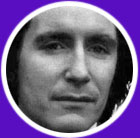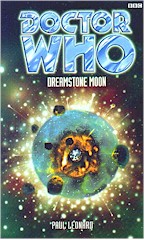 |
Dreamstone Moon
|
BASIC PLOT DOCTOR COMPANIONS MATERIALISATION CIRCUIT Pg 58 The miner's station on the Dreamstone Moon. PREPARATORY READING CONTINUITY REFERENCES Pg 8 "To think that all she'd had to worry about once was her new fringe." Longest Day, and a lovely piece of continuity because it's not at all important. " - cold, cold, with scratches along his cheeks and he wasn't breathing wasn't breathing pinching his nose watching for his chest to rise blowing desperate blowing wake up lips pressed hard against his - " Longest Day again, and the big kissing moment in stream of consciousness flashback. Pg 10 "The TARDIS translation system must be too far away, thought Sam." The Masque of Madragora et al. Pg 17 Another brief reference to the Kusk of Longest Day. Pg 18 "You ever seen a Dalek war zone?" War of the Daleks. Pg 22 "He'd heard of such things happening, since the Dalek war and the subsequent weakening of Earth's control in this sector". The Dalek Invasion of Earth. It also links quite nicely with much the same time period as presented in Fear Itself, as well as utterly failing to gel with the presentation of Earth in Legacy of the Daleks. See Continuity Cock-Ups. Pg 25 "I wish I'd been born on Earth before the Daleks wrecked it." The Dalek Invasion of Earth. Pg 37 "Where is home, anyway? Ha'olam? Ryman's World?" Ha'olam will be the location for Seeing I. We haven't heard of Ryman's World anywhere else yet, although I imagine photocopying's cheap there. (You'll probably only get this if you're a UK resident.) Pg 40 "Sam wished she'd paid more attention to the Doctor's historical ramblings on the early twenty-third century. All she could remember reading from this period was a whale song book." We saw her reading this in Genocide. Pg 41 "He looked at the cat he'd been given on Earth after his most recent battle against the Daleks." Legacy of the Daleks. "He'd made enquiries at every post office and missing-persons bureau he dared visit: human, Draconian, Tractite, Chelonian, Besiddan, Arachnon, Krakenite... the lot. He'd visited Threadworld, wrapped himself in the toffee-like Thread Helmets and traced sightings of humanoids anywhere in the Centrum." Quite why he did all this rather than head straight for the Kusk ship that was the only place Sam could actually have been is rather beyond me, but ours is not to reason why. In order: we saw the visit to Earth in Legacy of the Daleks. Draconians are from Frontier in Space, although they haven't made any contact with Earth yet. Tractites were first seen in Genocide. Chelonians come from The Highest Science originally, while the remainder are new to this novel. Pg 46 "Do you like Cetacean [...] They're a musical band. A lot of young humans are into them?" They're also a race of intelligent dolphins, as seen in Storm Harvest, Companion Piece and Heritage. Pg 58 "I wanted to ask about the management of the anti-Weather Control demonstrations in the 2040s." Presumably connected to the development of the Gravitron as seen in The Moonbase. Possibly a reference to Weather Control in The Seeds of Death, but unlikely, as that would seem to be set chronologically after the former adventure. Pg 64 "But then, he didn't look like anyone sensible at all. More like someone in search of a fancy-dress party." Damn good guess. The Telemovie. Pg 76 "'No, I don't think that's right,' said the Doctor. 'Check in the manual.'" Flashbacks to Paradise Towers. Pg 77 "I'm the Doctor, and I used to be a Special Scientific Adviser to UNIT, when there was one." Spearhead from Space and so on. UNIT no longer exists, although UNISYS did in the 2060s (Alien Bodies) while Cold Fusion makes clear that the Unitatus would go right through for the next several hundred years. Pg 83 "Her voice was clipped, almost artificial. Like a robot. Like a - Don't even think it." He didn't think 'Dalek' in the wake of The Dalek Invasion of Earth. Pg 111 "Black-and-gold Space Marine Specials uniforms." This is a possible precursor of the blue and gold uniforms of Adjudicators such as Chris and Roz (Original Sin et al). Pg 123 "If he was the UNIT Scientific Adviser working with Brigadier Lethbridge-Stewart, from my information he'd be about two hundred and fifty years old." Spearhead from Space et al, but also, more relevantly, proof that Tchike's suppressing of all information concerning the Doctor from Alien Bodies is clearly something that did not last. Pg 124 "My husband is very much older than me, you know. I know he doesn't look like it, but he takes antiagathics." The only one we know of in the Doctor Who universe is Spectrox, from The Caves of Androzani. Anyone who's watched the Babylon 5 episode 'Deathwalker', upon reading this, instantly thinks 'That should read "Antiagapic".' It shouldn't; it turns out that Babylon 5 got it wrong. "His first wife was a Dalek Killer, you see. It was the only way out, in those times. And so he lost her, and then he lost their child to one of the plagues." DKs are normally only taken from the ranks of convicted criminals by the twenty-fifth century (see Love and War, Deceit), but here they clearly could be anybody. The 'plagues' may be a reference to the Dalek plague which came as a precursor to The Dalek Invasion of Earth, but may equally be something that happened in the aftermath. Pg 130 "She remembered the Tractite. Burned, dead." Genocide. Pg 142 "Sam felt a wild surge of joy, and at the same time her face flushed deep red. This was going to be very embarrassing, and there wasn't time to explain - " Memories of Longest Day again. Pg 165 "The Doctor met his eyes. Daniel was suddenly sharply aware of the almost mesmerising power there, of the alienness of this so often warm and human-seeming person." The Doctor's power of personality, used at least twice in this book (the other point is at Pg 100, and you could argue that talking Anton to death on Pg 245 is the ultimate extension of the ability) suggests that Leonard's been singing from the old, pre-Congenital Idiot, hymn-book. It fits with the Doctor's portrayal in both The Bodysnatchers and Genocide. Pg 183 "Now she might be dead. Another One." Sara, Katarina, Adric, Roz. Pg 247 "The Dreamstone Miner's going to pick us up. Tina says she'll drop you off at Ha'olam." Leading into Seeing I. " - wake up goodbye kiss - " More memories of that classic moment from Longest Day. OLD FRIENDS AND OLD ENEMIES NEW FRIENDS AND NEW ENEMIES CONTINUITY COCK-UPS PLUGGING THE HOLES [Fan-wank theorizing of how to fix continuity cock-ups] FEATURED ALIEN RACES Krakenites: Massive swamp-dwelling creatures with one large eye, many tentacles and three legs. Zmm-Zmm: Insectoids with wings and antennae. If you insult them, you have to forfeit a pint of blood every week to feed their young. Jono is a Besiddian, a cat-like humanoid creature. It's doubtful that she's of the same species as the Sisters of Plenitude from New Earth, but it's possible I suppose. It would appear that Besiddians have a very high alcohol tolerance as she's had four or five bowls of Creme de Menthe. Male Besiddians are 2 1/2 metres tall, twice as heavy as the females and half as intelligent. Kram is a large spider, but it's not clear whether or not he's of the same species as the... Arachnons, spider-like beings who are eaten by the females of their species after mating, which is, to put it mildly, unfortunate. That said, they're quite blase about it. Chorodorons: white and six-limbed. Esqueekeemians: tiny, metal-winged tour-guides with a silly name. (Seriously, planet names and race names, when named by the race themselves, should be short and to the point. We're called, essentially, 'man' and live on a planet called, essentially 'mud'. Still, the new series has given us Raxacoricofallapatorius, so I suppose I shouldn't complain too much.) An Ixcallex is a millipede/caterpillar-type creature with a grey, segmented carapace. They use peroxide propellants. Vorsedds have horns, although it would appear that the females don't. They also have spines instead of hair and cheeks flushed red. Also mentioned are Borlogs and Geomydes. FEATURED LOCATIONS The Kusk ship, drifting in space after the end of Longest Day. The Dreamstone Moon, satellite of Mu Camelopides VI, specifically the main mining outpost and the protestor's camp, as well as various areas underground. In orbit above the Dreamstone Moon, including on a hospital ship, in a hospital ship escape pod, and the ship Unanimity. Mu Camelopides VI. IN SUMMARY - Anthony Wilson |

|